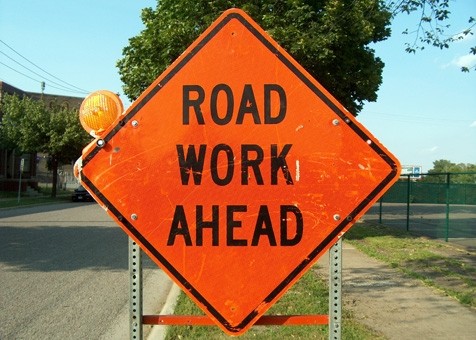Road Construction Safety Topics

According to the Bureau of Labor Statistics, road construction laborers suffer one of the highest rates of on-the-job injuries and fatalities. The job is rigorous, demanding and hazardous. Some of this is just part of the nature of the work, but workers, supervisors and policy writers can make the job a lot safer by training in several key areas.
Traffic Safety
By definition, road construction laborers work in the middle of traffic. Even with proper posting, mandatory reduced speeds and signal personnel, simple auto accidents still hurt and kill road construction workers every year. Training in traffic awareness, control techniques and emergency response will help reduce those casualties. This is especially important for flaggers, as they not only work to keep their coworkers safe but also are essentially "running point" for the team.
Equipment Operation
Road construction involves different kinds of heavy equipment, many of which have hot parts, moving pieces or both. Training in how that equipment works is vital, even for personnel who won't be personally operating the equipment. Further training in signaling and communication while that equipment is running can also reduce casualties. Project planners should also be made aware of realistic productivity statistics for the equipment on-site in order to prevent rushed conditions.
Hazardous Materials
Putting down a road includes working with hot materials, sharp materials, toxic materials and fumes. In addition, replacement and demolition projects often put workers into contact with dangerous materials that have since been banned, such as asbestos and lead-based paint. Workers need to be trained in proper handling of those materials and for signs and symptoms that another co-worker has been compromised by a hazardous material.
Environmental Hazards
Exposure is the No. 1 cause of hospitalization among road construction workers. Though frostbite and hypothermia do happen, sun stroke/heat exhaustion is the main culprit. Construction laborers encounter environmental hazards ranging from weather to mudslides to dangerous animals. General training is an important countermeasure, which must be combined with specific briefings for the area construction takes place.
Treatment
Road construction is not only hazardous but also often takes place a long way from medical attention. Basic first aid and first-responder techniques are important to prevent minor injuries from becoming serious and serious injuries from becoming fatal. Beyond general knowledge, all crews must also be trained in the location of first aid supplies and organization protocol to get necessary help on-site as quickly as possible.
Traffic Safety
By definition, road construction laborers work in the middle of traffic. Even with proper posting, mandatory reduced speeds and signal personnel, simple auto accidents still hurt and kill road construction workers every year. Training in traffic awareness, control techniques and emergency response will help reduce those casualties. This is especially important for flaggers, as they not only work to keep their coworkers safe but also are essentially "running point" for the team.
Equipment Operation
Road construction involves different kinds of heavy equipment, many of which have hot parts, moving pieces or both. Training in how that equipment works is vital, even for personnel who won't be personally operating the equipment. Further training in signaling and communication while that equipment is running can also reduce casualties. Project planners should also be made aware of realistic productivity statistics for the equipment on-site in order to prevent rushed conditions.
Hazardous Materials
Putting down a road includes working with hot materials, sharp materials, toxic materials and fumes. In addition, replacement and demolition projects often put workers into contact with dangerous materials that have since been banned, such as asbestos and lead-based paint. Workers need to be trained in proper handling of those materials and for signs and symptoms that another co-worker has been compromised by a hazardous material.
Environmental Hazards
Exposure is the No. 1 cause of hospitalization among road construction workers. Though frostbite and hypothermia do happen, sun stroke/heat exhaustion is the main culprit. Construction laborers encounter environmental hazards ranging from weather to mudslides to dangerous animals. General training is an important countermeasure, which must be combined with specific briefings for the area construction takes place.
Treatment
Road construction is not only hazardous but also often takes place a long way from medical attention. Basic first aid and first-responder techniques are important to prevent minor injuries from becoming serious and serious injuries from becoming fatal. Beyond general knowledge, all crews must also be trained in the location of first aid supplies and organization protocol to get necessary help on-site as quickly as possible.
- d5e81b224fb2f24a26af0b9c9d60233311.jpg